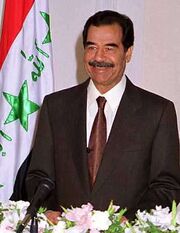| ||||||||||||||||||||||||||||||||||||||||||
Saddam Hussein Abd al-Majid al-Tikriti (Arabic: صدام حسين عبد المجيد التكريتي Ṣaddām Ḥusayn ʿAbd al-Maǧīd al-Tikrītī; 28 April 1937 – 30 December 2006) was the dictatorial President of Iraq from 16 July 1979 until 9 April 2003. A key player in the July 17, 1968 coup that installed the pan-Arabist Ba'ath Party, Hussein became one the vice presidents of the country, and began accumulating power throughout the 1970s. By 1976, he was the de facto ruler of the country, becoming the de jure president in 1979. In the lead-up, he established the security service the repressed his enemies and nationalized oil and foreign banks. He initiated a war against Iran in 1980 that lasted until 1988. In 1990, his decision to invade Kuwait prompted an international coalition of both Western and Middle Eastern countries to force his ouster in what is commonly called the Gulf War.
Throughout the remainder of the 1990s, Hussein's Iraq was heavily constrained by no-fly zones and economic sanctions. In March 2003, on the pretext that Hussein had somehow played a part in the September 11, 2001 attacks on the United States and that Hussein was in possession of weapons of mass destruction, a coalition spearheaded by U.S. President George W. Bush toppled Hussein. After briefly fleeing, Hussein was captured in December 2003. He was tried for crimes against humanity in 2006, and hanged in short order.
Saddam Hussein in Alpha and Omega[]
Years after his death, as the world appeared to be entering the End of Days, Saddam Hussein's reign still had an impact on the Middle East and the world. American evangelist Lester Stark called Hussein the Nebuchadnezzar of the modern era.[1] When an IDF Colonel learned of the simultaneous deaths of Iran's President, Defense Minister and Grand Ayatollah, he reflected that even Saddam Hussein in his "glory days" could not have pulled off such a feat.[2]
Saddam Hussein in State of Jefferson[]
In 1981, Saddam Hussein ordered an invasion of Iran on the mistaken belief that the recent revolution had left the country vulnerable. The resulting war soon proved a bloody stalemate. The only upside was that it did lead to the end of the hostage crisis that had begun in 1979, and allowed the American hostages, including Mark Gordon, to go home.[3]
References[]
- ↑ Alpha and Omega, pg. 70, ebook.
- ↑ Ibid., pg. 226.
- ↑ https://www.tor.com/2020/01/08/tie-a-yellow-ribbon-harry-turtledove/
| Political offices (OTL) | ||
|---|---|---|
| Preceded by Ahmed Hassan al-Bakr |
President of Iraq 1979–2003 |
Succeeded by Jay Garner as Coalition Provisional Authority Director of the Office for Reconstruction and Humanitarian Assistance of Iraq |
| Prime Minister of Iraq 1979–1991 |
Succeeded by Sa'dun Hammadi | |
| Preceded by Ahmad Husayn Khudayir as-Samarrai |
Prime Minister of Iraq 1994–2003 |
Succeeded by Mohammad Bahr al-Ulloum as Acting President of the Iraqi Governing Council |
| Party political offices (OTL) | ||
| Preceded by Ahmed Hassan al-Bakr |
Leader of the Ba'ath Party 1979–2006 |
Succeeded by Izzat Ibrahim ad-Douri |
| ||||||||||||||||
| ||||||||||||||

